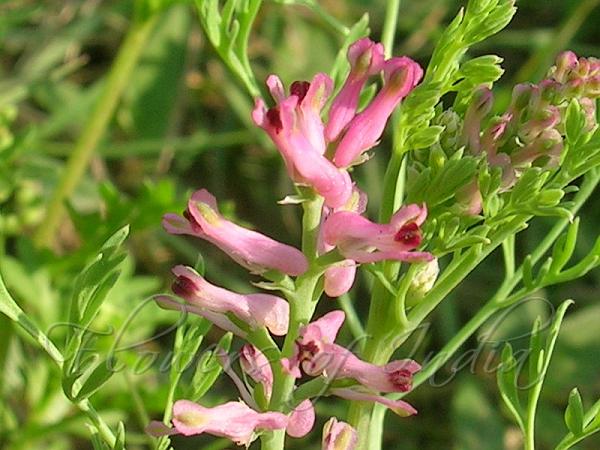|
| Indian Fumitory |
|

|

| File size | 146603 |
| Original date | 3/10/07 3:24 PM |
| Resolution | 800 x 600 |
| Flash | Flash did not fire, auto |
| Focal length | 8.0mm |
| Exposure time | 1/151s |
| Aperture | 5.5 |
| Focus Distance | |
| Metering Mode | Partial |
| Camera make | NIKON |
| Camera model | E3700 |
| Sensor type |
|
|
|
|
Photo: |
Botanical name: Fumaria indica Family: Papaveraceae (Poppy family)
Synonyms: Fumaria parviflora var. indica, Fumaria vaillantii var. indica
Synonyms: Fumaria parviflora var. indica, Fumaria vaillantii var. indica
Indian Fumitory is a delicate much-branched annual
herb with clusters of tiny pale-pinkish to whitish flowers, each 5-6 mm
long. Sepals are minute. Upper petal has short, somewhat down-curved
sac-like spur. Flower-stalks are erect, as long or slightly shorter
than the laceshaped bracts. Leaves are 2-3 times cut into narrow
pointed segments, about 1 mm broad. Stems are glaucous, leafy, 5-30 cm
long. Fruit is round, about 2 mm. Indian Fumitory is found throughout
the Himalayas, up to altitudes of 2400 m. It is also found in Western Ghats.
Flowering: April-May.
Medicinal uses:  The plant is sold under the name pitpapra in Ayurvedic bazaars. It is
also used in the Unani system of medicine and incorporated into trifala
shahtara. Indian Fumitory is used in aches and pains, diarrhoea, fever,
influenza and liver complaints. The herb mixed with honey mar be taken
internally to prevent vomiting. A cold infusion of the plant is used to
treat wasting diseases of children and to help cooling during fever and
in the treatment of constipation and dyspepsia. It is used as a blood
purifier for skin diseases and applied externally in leucoderma and as
a fomentation for swollen joints. The dried plant is also used as an
anthelmintic, diuretic and diaphoretic and, in combination with black
pepper, for jaundice.
The plant is sold under the name pitpapra in Ayurvedic bazaars. It is
also used in the Unani system of medicine and incorporated into trifala
shahtara. Indian Fumitory is used in aches and pains, diarrhoea, fever,
influenza and liver complaints. The herb mixed with honey mar be taken
internally to prevent vomiting. A cold infusion of the plant is used to
treat wasting diseases of children and to help cooling during fever and
in the treatment of constipation and dyspepsia. It is used as a blood
purifier for skin diseases and applied externally in leucoderma and as
a fomentation for swollen joints. The dried plant is also used as an
anthelmintic, diuretic and diaphoretic and, in combination with black
pepper, for jaundice.
 The plant is sold under the name pitpapra in Ayurvedic bazaars. It is
also used in the Unani system of medicine and incorporated into trifala
shahtara. Indian Fumitory is used in aches and pains, diarrhoea, fever,
influenza and liver complaints. The herb mixed with honey mar be taken
internally to prevent vomiting. A cold infusion of the plant is used to
treat wasting diseases of children and to help cooling during fever and
in the treatment of constipation and dyspepsia. It is used as a blood
purifier for skin diseases and applied externally in leucoderma and as
a fomentation for swollen joints. The dried plant is also used as an
anthelmintic, diuretic and diaphoretic and, in combination with black
pepper, for jaundice.
The plant is sold under the name pitpapra in Ayurvedic bazaars. It is
also used in the Unani system of medicine and incorporated into trifala
shahtara. Indian Fumitory is used in aches and pains, diarrhoea, fever,
influenza and liver complaints. The herb mixed with honey mar be taken
internally to prevent vomiting. A cold infusion of the plant is used to
treat wasting diseases of children and to help cooling during fever and
in the treatment of constipation and dyspepsia. It is used as a blood
purifier for skin diseases and applied externally in leucoderma and as
a fomentation for swollen joints. The dried plant is also used as an
anthelmintic, diuretic and diaphoretic and, in combination with black
pepper, for jaundice. | Identification credit: T.A. Kain | Photographed in Sundar Nursery, Delhi. |
• Is this flower misidentified? If yes,